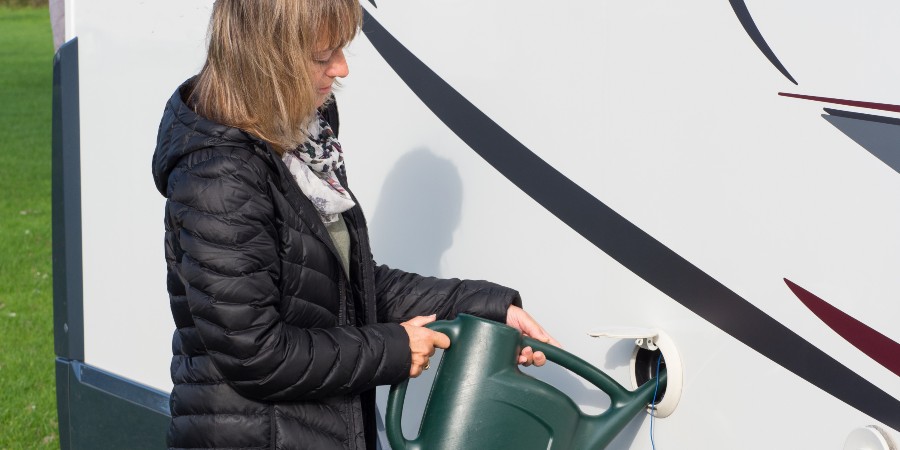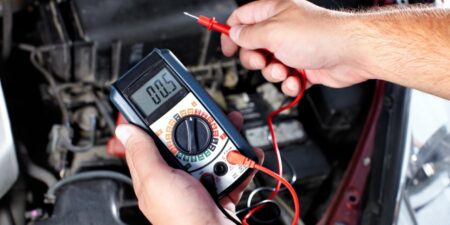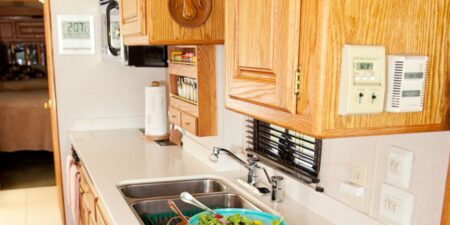RV water systems supply fresh water and store wastewater when camping. As water is a necessity for life, knowing how RV water systems work — and how to maintain them — is vital to enjoying your frugal camping adventures. Here’s what RV Troopers discover about RV water systems:
RV Fresh Water
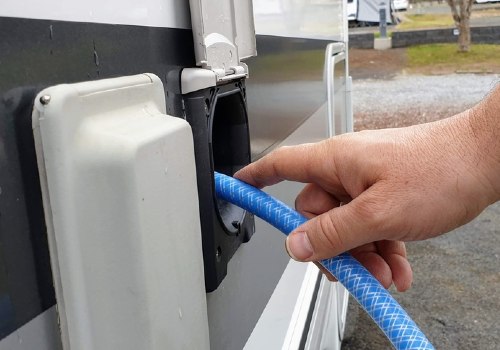
Recreational vehicles typically have two sources of potable (drinkable) water. The first water source is the municipal or private water system at the campground. Campers attach their rig to this source at the faucet at each campsite.
Because the source, pressure, and quality are unknown, most RVers use a (white) drinking water hose, a pressure regulator, and an in-line filter between the campsite faucet and the RV.
The pressure regulator reduces incoming water pressure to below 45 psi to not damage smaller RV water lines. Even if the water is potable, it may contain minerals and bacteria that are unfamiliar to the campers’ digestive systems.
Many RV rigs have an additional filter system inside that makes the water safer to drink. Other campers simply use bottled water for drinking, cooking, and pets.
The second source of water in most RVs is freshwater tanks. They range from 8- to 120 gallons based on the size and purpose of the RV. Smaller systems use a hand-operated pump to draw water from the storage tank to the inside faucet(s).
Larger systems use an electric pump built into the freshwater system. The electric pump is powered by a 12-volt DC electric system. Fresh water tanks are typically installed below the RV floor at the center or near axles to support the weight of the water (about 8.35 pounds per gallon).
Fresh water tanks have an inlet, accessed through the driver-side wall of the RV, and a drain below or near the bottom edge of the tank.
There’s one more water tank in most RVs: the hot water tank. As fresh water enters the rig from a hose, the system also fills the small hot water tank (typically 6 to 20 gallons in size).
Most hot water tanks are heated with propane fuel, others with electricity, and some with both.
RV Waste Water
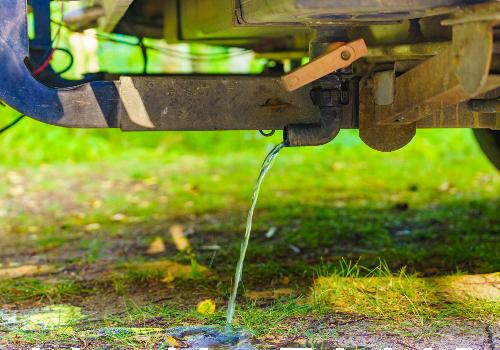
Want to Connect With a Community of Over 1,078 RV Enthusiasts?
Fresh water is used throughout recreational vehicles to wash dishes, take showers or baths, and flush the toilet. The gray water tank holds wastewater from sinks, showers, and bathtubs. The separate black water tank stores waste water and debris from the toilet.
The gray water tank is relatively clean water, not potable, but not full of waste. On-board washer/dryer combinations will require a larger gray water tank. The black water tank requires chemical treatment to break down waste and reduce odors.
Larger RVs often have a black-water tank rinser built in to backflush waste from the tank and keep level sensors clean. Other RVers use tank-cleaning wands or backflush attachments.
The larger RVs also may have two bathrooms and two black water tanks, though they may drain through a single black water valve.
RV Water System Maintenance
Maintaining RV fresh and wastewater systems can reduce the problems and stresses of camping. Here are some suggestions for RV water system maintenance.
- If the RV is new or has sat for a long period, sanitize the fresh water tank with a weak solution of bleach followed by a clear-water rinse.
- Depending on the local climate, consider winterizing your RV by clearing all water lines and adding RV water system antifreeze following product directions.
- If you winterize your RV, be sure to drain the hot water heater reserve tank following manufacturer instructions.
- Based on your camping plans, fill the fresh water tank before starting out if you expect to be dry camping. Partially fill the tank if you will need a sink or toilet water as you travel to your destination.
- Remember to turn off the freshwater pump when not in use or when connected to campground water.
- If you plan to be parked for more than a few hours, turn on the hot water system.
- If you connect your sewer line hose to the campsite sewer system, only open the gray water valve. Keep the black water valve closed until ready to leave so that wastewater can be used to flush the tank.
- Your black water tank should be at least two-thirds full before dumping.
- Finally, periodically spray the waste valve handle stems with silicone lubricant, NOT WD-40, as it is a Water Displacement fluid and not a pure lubricant.
RV campers should know how to conserve water. Read my article on RV Water Saving Tips.
RV Water System Explained in Depth (Video)
"Man cannot discover new oceans unless he has the courage to lose sight of the shore."
-- Andre Gide

